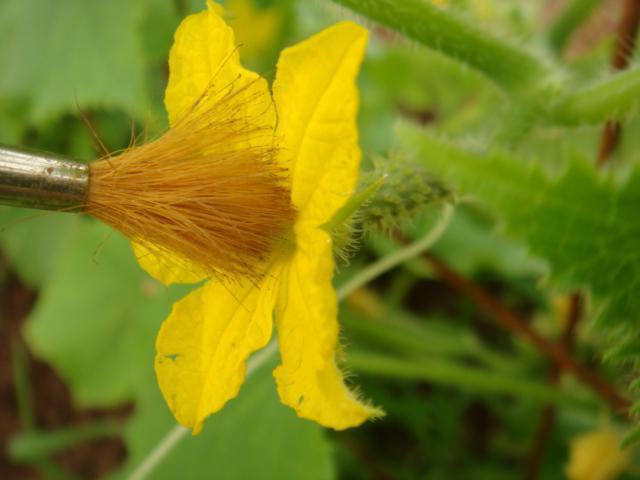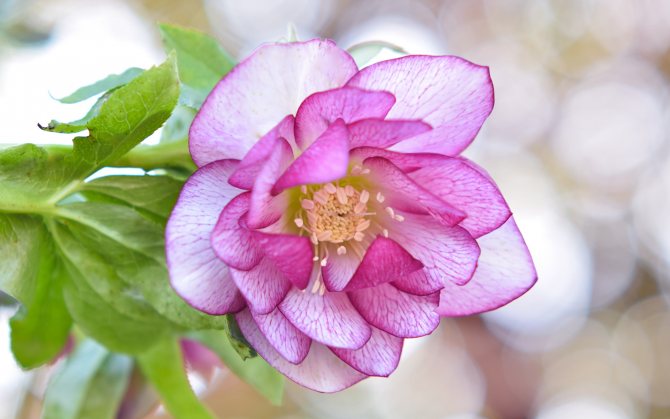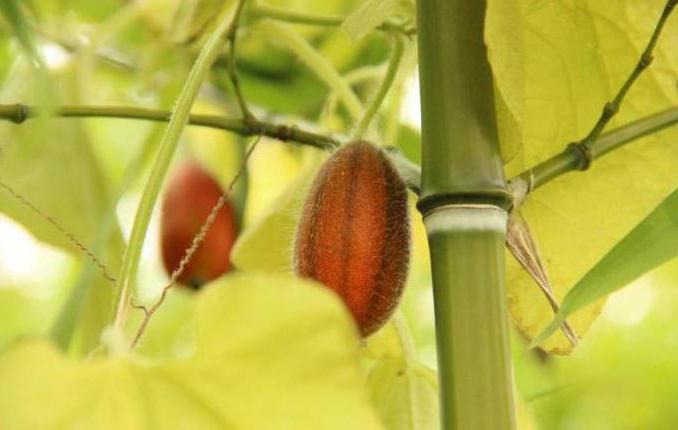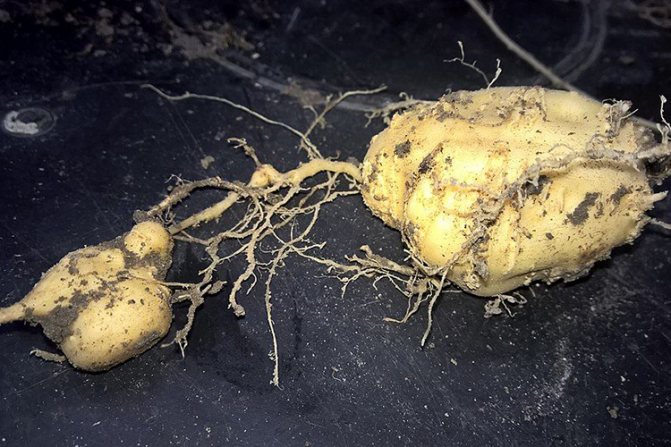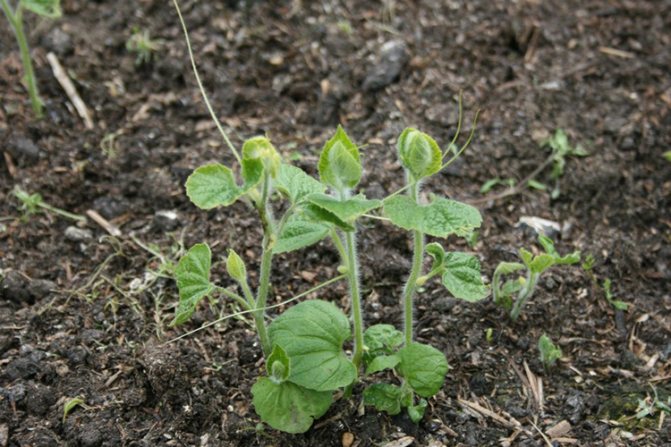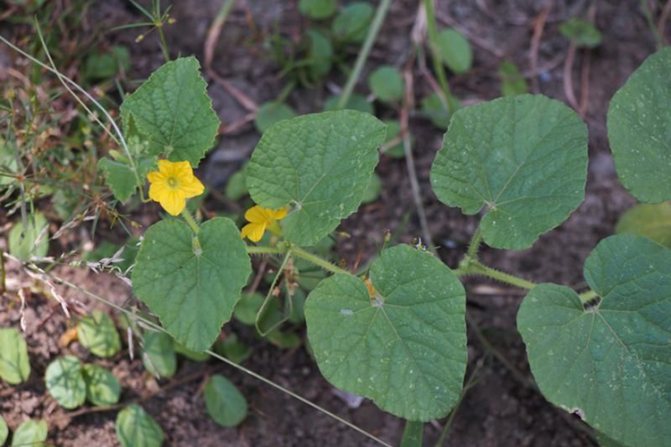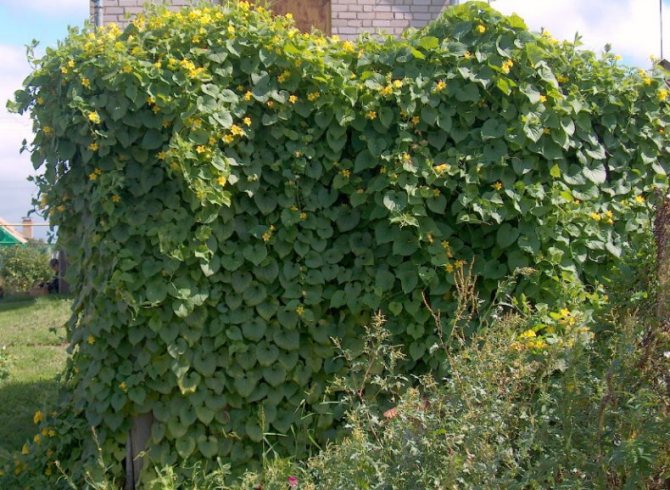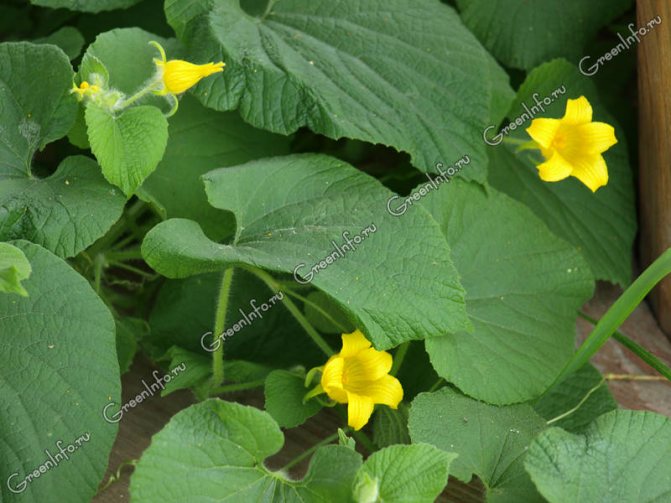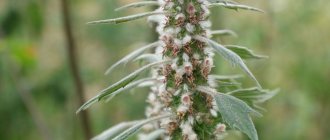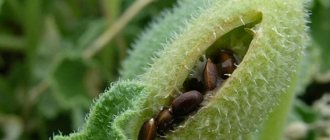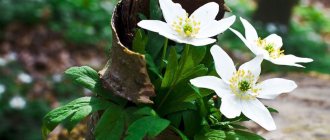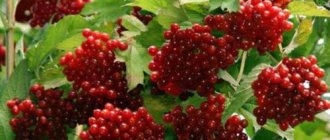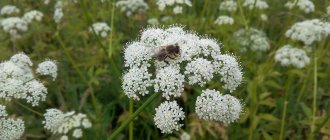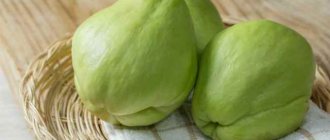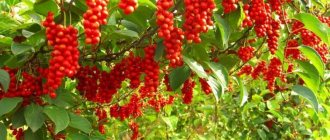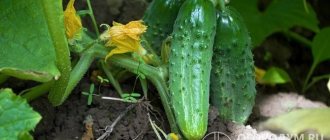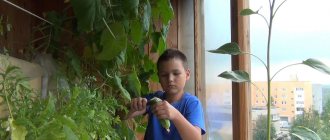At the end of summer I was visiting and treated me to a very strange pickled marsh-green vegetable, slightly colored on one side in a yellow-brown color. And they said it was a red cucumber. They showed a garden bed and I even took a photo. And then she saw a bowl of red cucumbers. In the jars, it was the same color, and in the bowl were small, pot-bellied, slightly pubescent red cucumbers. The culture was christened by the people with the red cucumber, and its real name is Tladiant. It turns out that in the green phase this cucumber can be pickled, and in the red phase it can be eaten fresh or cooked with jam. I liked the taste of pickled red cucumber.
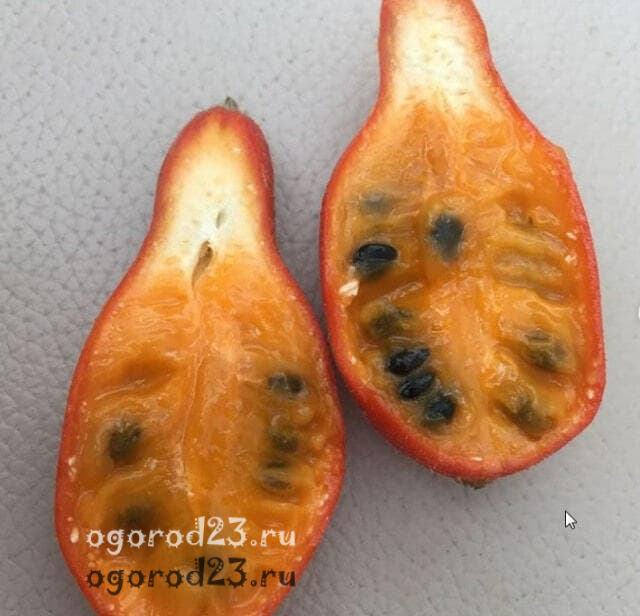
It looks like a tladiant in a cut
Unusual, a cross between a cucumber and a zucchini, only slightly sweet and the seeds-seeds were somewhat similar to watermelon, albeit small, black.
And I didn't really like the taste of fresh red cucumber. Well, somehow sweet cucumber is nonsense for me. Although all the guests, tasting a ripe red cucumber, clicked their tongues and shared enthusiastic gustatory impressions. Some claimed that the taste is very similar to kiwi, only softer and sweeter. Others tasted notes of mango. Still others have found similarities to pineapple. Perhaps we all have different tastes ...
They even gave me a few seeds, but, leaving, alas, I forgot this packet, I did not take it with me.
But, nevertheless, I wanted to learn more about this culture. Can a Tladian be raised here, and if so, how to take care of him?
Basic description
Tladiana can be safely called an exotic plant. Today it is grown in the USA, Asia and Europe. The homeland is considered to be the Far East (Primorsky Territory of Russia and Northeastern China). Tladianta is growing fast enough, so it is gaining more and more popularity with novice and experienced florists.
Botanical description
Tladianta Doubtful grows naturally in coastal areas, among thickets of bushes and in coastal meadows. She is ranked among the Pumpkin family, a group of herbaceous vines.
Root and aerial part
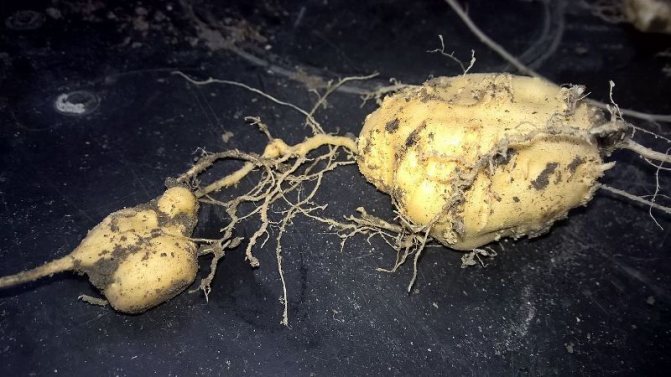

- The root system of the plant is presented in the form of thick and strong shoots. At their ends, tubers appear from 2 cm to 8 cm in size. This is a storage organ. Tubers are found underground and above the surface of the soil.
- From the tubers that are located above the surface of the soil, young shoots are formed annually, since the entire aboveground part dies off after fruiting in the autumn period. The advantage of these tubers is that they are frost hardy and do not die. Thanks to this, the plant increases its growing area.
- All parts of the plant located above the soil surface are pubescent. There are a lot of stems and villi grow on them, rather rigid in structure. Also, tendrils grow on the stems, which cling to various supports.
- A plant blooms only when it can develop and grow on a support upward. If there is no support near the tladiant and it is located horizontally, then there will be no flowering. The result is a solid green carpet of green foliage.
- The main stem is densely covered with leaves, quite powerful. Can be extended up to 5 m in height.
- Leaves of a very bright green shade of light tones. Their length is from 5 cm to 10 cm. They are located on petioles and have pubescence on the upper and lower sides.The shape resembles a heart. The upper part of the leaves with a sharp tip, the edging of the leaf has teeth.
- Leaves are of different ages. When they are spread along the wall or are on a support, they look very decorative.
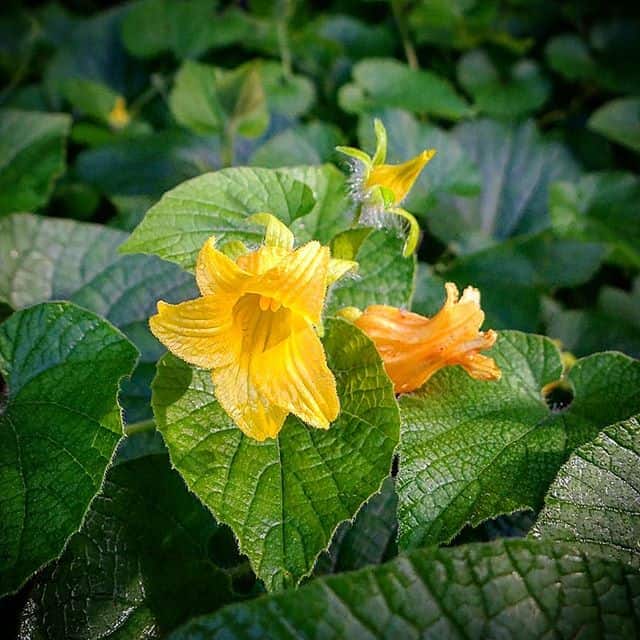

Bloom
- Tladiant is a dioecious plant. On one specimen, male and female flowers grow, which have a yellow or greenish-yellow color.
- Male flowers bloom earlier, solitary, collected in racemose or umbellate inflorescences, their diameter is about 3 cm. The shape of the flower resembles a bell. Each flower has 5 petals.
- Female flowers bloom later and in lighter colors. They are flat and often grow singly. The female flowers are located just above the ovary. Flowering is very long. It starts in early summer and ends in the second half of September.
Pollination
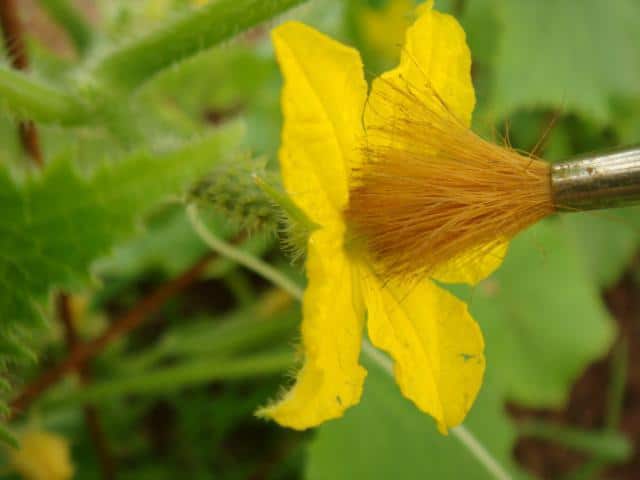

The red cucumber is pollinated by one - the only bee from the genus Ctenoplektra. She spends the night only in a male flower. Other insects are indifferent to this plant. There is not always a pollinator nearby, so the tladiana reproduces in a vegetative way.
You can artificially pollinate the plant. To do this, brush first over the male flower, and then over the female. Or pick a male specimen and run it over the female flowers. If ovaries and then small green cucumbers appear, then pollination was successful.
Fruit
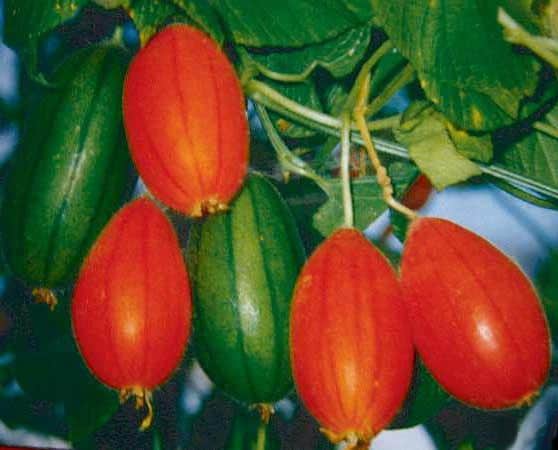

- They are similar to cucumbers, only the size, color, taste and structure are not at all the same. The fruit changes color as it ripens: from green to red, and then stripes appear. When red cucumbers ripen, the pile from the surface of the skin disappears, the surface becomes smooth.
- Fruit ripening occurs from July and lasts until September. The taste is sweet and the flesh is juicy. There are many seeds inside the fruit, up to 100 seeds. They are covered with a dense skin of a dark shade.
- Red cucumbers are used in food by lovers of exotic fruits as a snack. You can make jam or jam from them.
In countries where tladianta does not grow as a cultivated plant, it is often considered a weed. This liana behaves quite aggressively and quickly recaptures large territories.
If you want to grow it on your site, then dig a piece of slate or plastic around the root perimeter to a depth of 60 - 80 cm so that it protrudes 10 cm above the soil surface. It is easy to control the aboveground part by timely pruning.
Healing properties
- In eastern countries, fruits used fresh or after heat treatment contribute to the normalization of the gastrointestinal tract, increase the body's defenses, and strengthen the immune system. It is an excellent antiseptic and anti-inflammatory agent.
- You can make medicinal decoctions from tubers and seeds, which are used as a diuretic and choleretic agent.
- For colds and upper respiratory tract infections, an infusion of flowers is used.
- People suffering from hypertension or headaches are advised to take a course of infused seeds, fruits and leaves of the plant.
- The plant tissues contain a large content of useful and necessary for the body macro and microelements, vitamins PP, C, A, B, as well as iron, potassium, magnesium, cobalt and phosphorus. Therefore, decoctions and infusions have a tonic effect.
However, when using it, you must consult with your doctor and remember that there may be an individual intolerance to one or more components.
The fruits of the plant have a high percentage of sugar, so this fruit is not recommended for patients with diabetes mellitus.
Where does the red cucumber grow
As I already mentioned, Southeast Asia, Northeast China, and the Philippines are the homeland of the Tladians. But we also, in Russia, have places where this vegetable grows wild: in the Far East. On the Internet, I met a photo, the author of which asks: they walked and met such a miracle on the shore, what kind of plant it was. The author lives in the Primorsky Territory. Photo taken at the end of October:
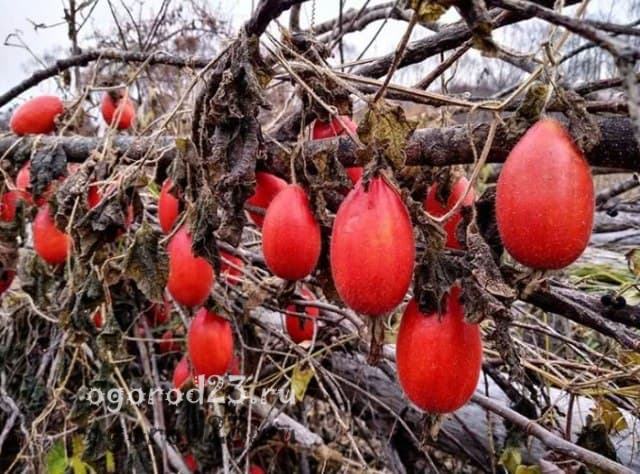

Tladiant in vivo
Landing technology
The tladian cannot be called a capricious plant, but still you need to know some of the features of its cultivation. Let's take a closer look at all the stages.
Choosing a place
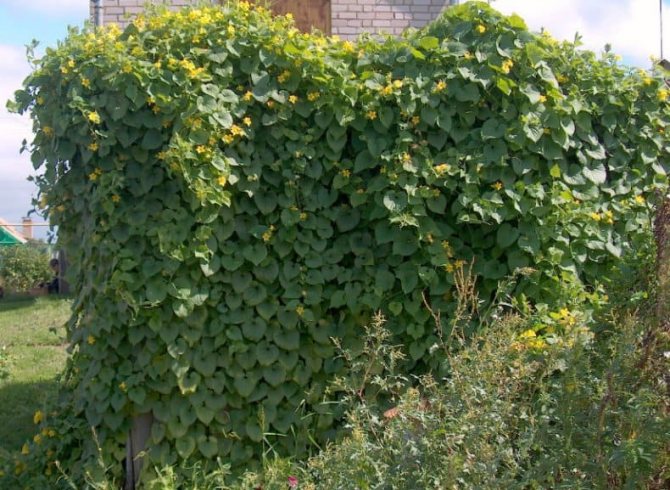

- Florists prefer to plant this vine on the southern or southeastern side of the site. The plant loves sun and warmth. It is undesirable to plant in places where there is dampness, drafts or north winds blow.
- A red cucumber grows well in partial shade, under the crown of tall trees, under the roofs of buildings.
- When planting, immediately put a root stop, as during the summer season the plant can grow several meters to the sides.
The soil
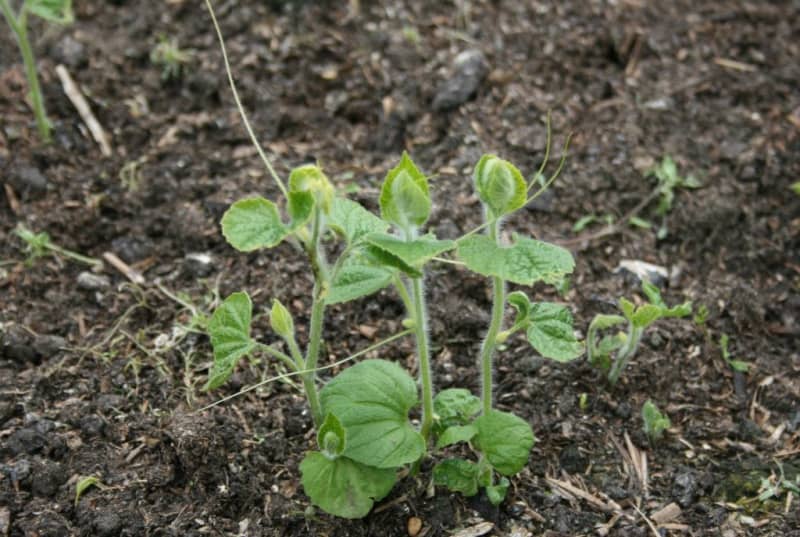

Tladianta grows on different soil, even on poor soil. But it is preferable to plant on loose and light soil. It is important that the required amount of oxygen and moisture is supplied to the root system.
Liana grows especially well on loam. It is recommended to regularly moisten the soil, especially in hot and dry weather.
Landing
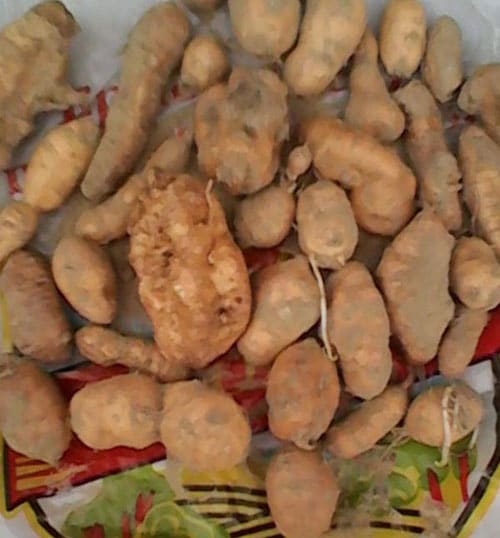

Tuberous way
- In the spring, plant the tubers to a depth of 6 - 8 cm. Place barriers at a distance of 50 cm so that the root system does not grow later.
- Seedlings of different sexes are planted in different places so as not to be confused later, since adult plants are very similar to each other.
- Tubers can successfully winter outdoors. There is no need to dig them up in the fall.
Seed method
- This method is quite lengthy. First, the seed must be well dried and then left for 3 - 4 months in a room where the temperature will constantly be +1 - 5 degrees.
- Immediately before planting, soak the seeds in hot water for 6 - 8 hours and then immediately plant them in moist soil to a depth of 2 - 3 cm.
- The room temperature should be low, but positive.
- At the end of spring, seedlings are planted in a pre-prepared place.
This method is almost never used, because at least 10 tubers are formed from one plant in one summer season.
The nuances of growing and breeding tladiants
When it comes to the Tladian, a confrontation of two opinions always arises in me - an optimist and a pessimist. Why? I'll tell you a little about this interesting plant and my experience, and you will draw a conclusion.
Description
This plant is unusual and quite decorative.
- His whips are thin, long, branched, often climbing in my garden to the top of an old apple tree to a height of more than 6 meters, where it peacefully coexists with another vine - lemongrass.
- The whole plant is covered with short and soft hairs.
- The leaves are small and cordate, emphasized elegant.
- Flowers resemble cucumber, dioecious.
The botanical name of this culture is doubtful Tladiant. Indeed, a lot of doubts arise about the need to find a plant in the garden. But if you manage to tame the tladian, then her decorative vines will delight with their uniqueness, decorating the resting places at their summer cottage!
Pollination
At home, the tladian is pollinated by a small bee that spends the night in male flowers that close at night. And in the morning she flies to feed on the nectar of female flowers, carrying pollen and pollinating them. The plant was brought to Russia, but the bee did not want to live. Our insects, bees, bumblebees, flies, etc., surprisingly, do not pay any attention at all to the flowers of the tladiant, flying by. There is still hope for artificial pollination.
The plant is dioecious, so some are only male, while others are female.
- If you use male tladiant flowers for pollination, you will get fruit with seeds.
- If you transfer the pollen of pumpkin, cucumber, melon (they are also good), then the cucumbers will be seedless.
When to plant
- It is better to sow seeds first for seedlings, in the month of March. Since their shell is hard, they need to be stratified for 3 months.Before sowing, the seeds must be soaked for 6 hours. It is better to plant it immediately in separate cups - this is convenient, because the seeds are large enough. In open ground, seedlings of tladiants can be transplanted no earlier than May.
- Young nodules can be planted in spring, when the soil warms up and frosts pass. Depending on the region, this can be the end of April - the beginning of May.
With the establishment of a stable subzero temperature, the aboveground part of the plant dies off, and the tubers easily tolerate even severe frosts. In spring, the vine gives new shoots that grow very quickly; in warm sunny weather, the daily growth can reach 10-12 cm.
This liana feels quite comfortable in the garden, in the room, and on the loggia. On a balcony or loggia, it is enough for her to provide a large box with fertile soil, and in the second year of life up to 10 tubers can form.
When breeding, it must be remembered that the tladiant is a dioecious plant. For this reason, it is necessary to have both males and females in order to obtain fruit. They differ in the same way as cucumbers:
- Female culture has a tiny ovary under the flower.
- The male has a smooth peduncle in this place.
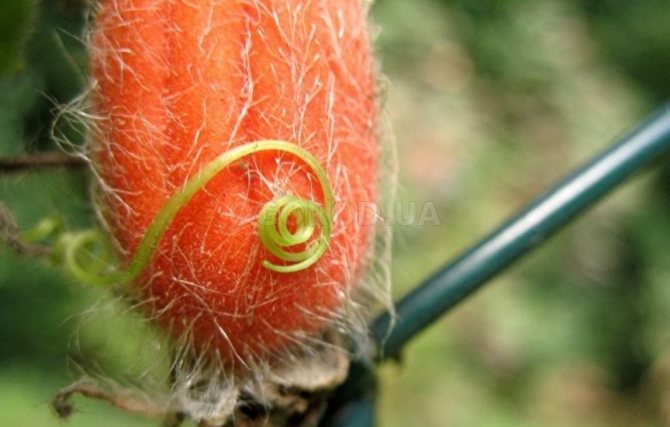

It is safer to immediately purchase a couple of packs of seeds and dig up the tubers from a couple of bushes. If the fruits still do not set, then the plant is manually pollinated with other pumpkin crops. However, in this case, you will not be able to get your own seeds.
How to plant
Tladiant is a hostile culture because it crawls through the garden very quickly and exterminates other plants. There are certain tricks that make it possible to avoid its increase. The landing site is limited - they break in slate or roofing material around the perimeter.
Red cucumber is grown using seeds, which are sold in special stores, or tubers. When using the latter method, the plants germinate quite quickly, for this reason, no auxiliary measures are taken. The tubers are placed directly in open ground in the spring, at approximately the same time as the potatoes are planted. Sowing depth - 8-10 cm. They have a sufficient supply of nutrients, which guarantee the early development of shoots.
The cultivation technique for seedlings is similar to the cultivation of an ordinary cucumber. In order to bring the appearance of the green ones closer, the seeds are soaked in warm water. After germination, they are placed in a solution of elements for 12 hours. To do this, 1-2 tablets of fertilizers are dissolved in 10 liters of water. A good result is obtained by soaking in a solution of sodium humate at the rate of 3 g of the drug per 10 l of water. Then the seeds are dried and sowed.
How to plant:
- It is safer to use high-calorie pots or 10 x 10 cm cups.
- For filling, soil mixtures are used - rotted peat and mullein (diluted in half with water) in a ratio of 4 to 1 or peat and humus (1 to 1).
- Sowing depth of seeds - 2 cm.
After that, watering is carried out, and the pots are placed at home or in a greenhouse. In the process of growth, the earth is additionally moistened as needed. Shoots are placed in the ground in the phase of 3-5 true leaves. The best distance between plantings is 60-70 cm.
Choosing a landing site
Care
The plant needs regular watering. Also, it is necessary to constantly loosen the soil and remove weeds. The structure of the root system is quite complex, so you need to ensure a constant supply of moisture and fresh air.
Fertilizer
- After a time when seedlings take root or small sprouts appear (if you planted tubers), you need to fertilize young plants. It is recommended to use mineral fertilizers or ammonium nitrate.
- During the period of emergence and development of buds, add phosphorus-containing preparations.
- During fruiting, the bush should be fed only with organic fertilizers: mullein solution (1:10 with water) or bird droppings.
- There is also such a feeding option: 1 glass of wood ash is taken for a three-liter jar. Then they insist for two days. Add 25 grams of superphosphate to the liquid and add water to make 10 liters. Under one bush, you need 5 liters of infusion.
- You can use cow dung, to which wood ash and superphosphate are added in equal parts.
Reproduction of tladiants
Choosing a landing site
It is possible to propagate tladiant by seeds, but much easier - tubers, which are planted in early spring or autumn to a depth of 6-8 cm.The distance between tubers is 60-70 cm.
At home, this dioecious plant is pollinated by a local wild bee, however, our bees, wasps and bumblebees do not pollinate this foreigner, so the cultivation of tladiandy will require manual pollination. Moreover, not only the male flowers of the plant itself are suitable as a source of pollen, but also pollen from zucchini, cucumber, pumpkin or squash. In this case, a seedless fruit is formed, but with a much better taste than when pollinated with its own pollen.
Doubtful tladianta is a wonderful ornamental plant. Its soft leaves, and very exuberant flowering for our latitudes, and, of course, its unusual fruits look very original.
For decorative purposes, this plant can be used, like any other fast-growing vine: for decorating places that need to be hidden; for landscaping a gazebo or veranda, arches or old trees. The best material for the construction of any "green walls", perhaps, can not be found.
The red tladiant cucumber is propagated by tubers that form on the lower shoots. Outwardly, they are very similar to regular potatoes. In order for the plant to not capture the entire garden plot, unnecessary tubers are dug up in the fall. New tladiant bushes sprout from the remaining ones in spring.
The tubers tolerate low temperatures well, so they are left in the soil for the winter. You can also dig them up and store them in the cellar until spring, wrapping them in foil. Tubers are planted with the arrival of the first heat. Most often, this work is carried out in April. Tubers are planted at a distance of 60-70 cm from each other.
Red cucumbers can also be propagated by seed. They have a characteristic black color. Round shape, small size. Before growing seedlings, the seeds must be soaked for 24 hours in cold, settled water. After that, they are transferred to a damp cloth, where they are left to germinate. As soon as the sprouts have appeared, you can plant the seeds in pre-prepared containers.
It is important to note that the seeds can be sown outdoors for the winter. However, during the first year, the tladiant will not bear fruit, since the plant spends all its energy on the formation of tubers.
Such a plant can reproduce both by seeds and by root tubers by dividing them.
In general, for the tladiana, the violent emergence of new shoots from its roots in the form of tubers is specific. They are called stolons and in huge volumes, these horizontal long shoots can increase over the season over a large area of land. For this reason, for preventive purposes, planting such a plant is recommended to be limited by digging any obstacles into the ground to a depth of up to half a meter, for example, slate sheets.
Breeding features:
- The division of tubers should be performed in the spring after the shoots have arisen, and immediately planted in the soil at the planned place.
- The landing distance is about 50 centimeters from each other, and 20 centimeters in depth will be enough.
- Immediately after planting, the shoots need to cling to something, for this reason it is easier and better to pull the twine, according to which your plant will "rise up".
In its homeland, as we remember, this dioecious plant has a personal "friend" for this purpose - the local wild bee. Our nature did not take care of such a comrade, because neither our bees, nor wasps, let alone bumblebees, pollinate the tladian.
In other words, tladiandy cultivation requires hand pollination. It is curious that not only the male flowers of the plant itself can be used as a source of pollen, but also pollen from the simplest garden pumpkin plant (the same cucumbers or squash). By the way, the fruit in this version will be, simply, without seeds and with better taste for use in food than the fruit obtained "naturally".
Testimonials
The opinion of summer residents about the advisability of growing a red cucumber was divided: some rejoice at the annual green hedge, others cannot cope with the wildly growing liana. As practice suggests, it all depends on the correct planting and care of the plant.
Valentina, Dzerzhinsk: «A friend, who has been growing it in the country for ten years, shared the tubers of a red cucumber. She taught me how to properly care for the plant. I planted the tubers near the house, my husband dug the slate into the ground to a depth of about a meter so that the rhizome would not spread throughout the entire territory. Now we have a green wall every year. We cultivate culture for the sake of decoration and do not bother with pollination. "
Vasily, Kursk: “Two years ago I bought the dubious Tladianta tubers on the announcement. In the first year, I did not know how to deal with these weaving shoots, everything around was overgrown. In the fall, I dug up the entire site, removed all the tubers and planted it in a new way, made a fence. Now the plant lives in a strictly designated place. "
Vadim, Voronezh: “I got interested in growing red cucumbers in my country house. I really liked how the plant wraps around fences and walls of houses. I dropped it off strictly according to the rules, dug in the slate. They say that special bees are needed for pollination, but in fact the plant must have female and male flowers. I bought three packs of seeds, grew seedlings, and as a result, I collected a small harvest of red fruits in August. Their taste is pleasant, sweet, but not for everybody. "
The use of fruits in cooking
Ripe vegetables contain a large amount of sugars, which allows use them not only fresh, but also processed as jams and preserves.
Pickled red cucumbers also have excellent taste.
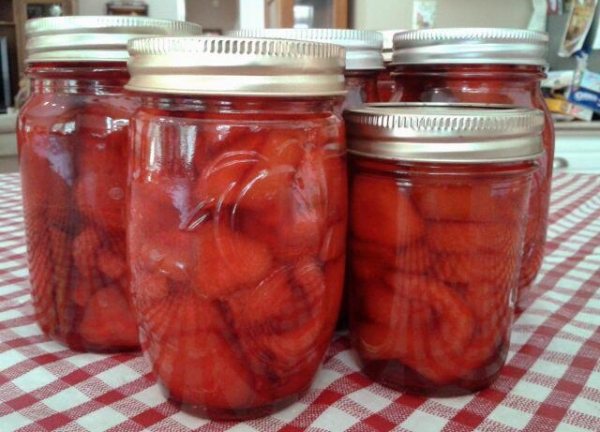

In cooking, they are used not only fresh, but also processed as jams and preserves.
Doubtful tladiada will provide you and your loved ones with an excellent delicacy and valuable medicine without much effort in leaving, it is only important to adhere to the above recommendations.
And also she will be an excellent decoration for your home or personal plot.
How does flower pollination take place?
Since red cucumbers are dioecious, female plants must be separated from male plants. Fruiting is carried out only with abundant pollination. Unfortunately, this function is performed only by the symbiont bee. When night falls, they hide in the flowers of the male plant. But as soon as the rays of the morning sun begin to peep through, the bees fly over to female buds in order to feast on nectar. This is the way the natural pollination of the flower occurs.
But in Russia this species of bees does not live, therefore often the tladiant does not bear fruit. However, gardeners have found a solution - artificial pollination. To do this, you need to take a small brush. With its help, pollen is transferred from the flowers of the male plant to the female by a simple method of application. You can also pollinate this plant with the pollen of other crops, for example, pumpkin, squash and others. The flowering period lasts until the very frost.
